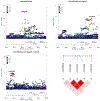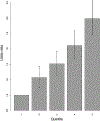A comprehensive analysis of SNCA-related genetic risk in sporadic parkinson disease
- PMID: 30146727
- PMCID: PMC6192521
- DOI: 10.1002/ana.25274
A comprehensive analysis of SNCA-related genetic risk in sporadic parkinson disease
Abstract
Objective: The goal of this study was to refine our understanding of disease risk attributable to common genetic variation in SNCA, a major locus in Parkinson disease, with potential implications for clinical trials targeting α-synuclein. We aimed to dissect the multiple independent association signals, stratify individuals by SNCA-specific risk profiles, and explore expression quantitative trait loci.
Methods: We analyzed participant-level data from 12,503 patients and 12,502 controls, optimizing a risk model and assessing SNCA-specific risk scores and haplotypes as predictors of individual risk. We also explored hypotheses about functional mechanisms and correlated risk variants to gene expression in human brain and protein levels in cerebrospinal fluid.
Results: We report and replicate a novel, third independent association signal at genome-wide significance level downstream of SNCA (rs2870004, p = 3.0*10-8 , odds ratio [OR] = 0.88, 95% confidence interval [CI] = 0.84-0.92). SNCA risk score stratification showed a 2-fold difference in disease susceptibility between top and bottom quintiles (OR = 1.99, 95% CI = 1.78-2.23). Contrary to previous reports, we provide evidence supporting top variant rs356182 as functional in itself and associated with a specific SNCA 5' untranslated region transcript isoform in frontal cortex.
Interpretation: The SNCA locus harbors a minimum of 3 independent association signals for Parkinson disease. We demonstrate a fine-grained stratification of α-synuclein-related genetic burden in individual patients of potential future clinical relevance. Further efforts to pinpoint the functional mechanisms are warranted, including studies of the likely causal top variant rs356182 and its role in regulating levels of specific SNCA mRNA transcript variants. Ann Neurol 2018;83:117-129.
Published 2018. This article is a U.S. Government work and is in the public domain in the USA.
Conflict of interest statement
Potential Conflicts of Interest
Nothing to report.
Figures




References
-
- Polymeropoulos MH, Lavedan C, Leroy E, et al. Mutation in the alpha-synuclein gene identified in families with Parkinson’s disease. Science 1997;276:2045–2047. - PubMed
-
- Singleton AB, Farrer M, Johnson J, et al. alpha-Synuclein locus triplication causes Parkinson’s disease. Science 2003;302:841. - PubMed
Publication types
MeSH terms
Substances
Grants and funding
LinkOut - more resources
Full Text Sources
Other Literature Sources
Medical
Miscellaneous

